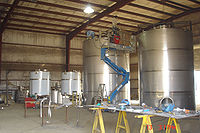Difference between revisions of "Process Tanks"
(Created page with "Category:Tanks, Vessels{{Knoppen}} <noinclude><!------------------------------------------------ * READ THIS FIRST * Only edit this page if you can improve the content. * Im...") |
PurplePen19 (talk | contribs) |
||
| Line 7: | Line 7: | ||
* Please start editing this page after the /noinclude | * Please start editing this page after the /noinclude | ||
* -------------------------------------------------></noinclude> | * -------------------------------------------------></noinclude> | ||
[[File:Process Tanks_1.jpg|thumb|200px|right|Process Tanks]] | |||
'''Process Tanks''' are commonly used in pressure rating, material (carbon or stainless steel), capacity, vents and fittings. Dished heads provide full drainage and maximum pressure ratings. Process tanks can be built to ASME specification. Other factory installed options include heavy-duty steel skirt or legs, insulation, heating and cooling jackets, interior linings and exterior finishes. | |||
==Common Design== | |||
Process design of tanks and vessels establishes the pressure and temperature ratings, the length and diameter of the shell, the sizes and locations of nozzles and other openings, all internals, and possibly the material of construction and corrosion allowances. This information must be supplemented with many mechanical details before fabrication can precede, notably wall thicknesses. | |||
==Video== | |||
<youtube>wHxpjS1THDE</youtube> | |||
Latest revision as of 21:16, 26 September 2012
Process Tanks are commonly used in pressure rating, material (carbon or stainless steel), capacity, vents and fittings. Dished heads provide full drainage and maximum pressure ratings. Process tanks can be built to ASME specification. Other factory installed options include heavy-duty steel skirt or legs, insulation, heating and cooling jackets, interior linings and exterior finishes.
Common Design
Process design of tanks and vessels establishes the pressure and temperature ratings, the length and diameter of the shell, the sizes and locations of nozzles and other openings, all internals, and possibly the material of construction and corrosion allowances. This information must be supplemented with many mechanical details before fabrication can precede, notably wall thicknesses.
Video
